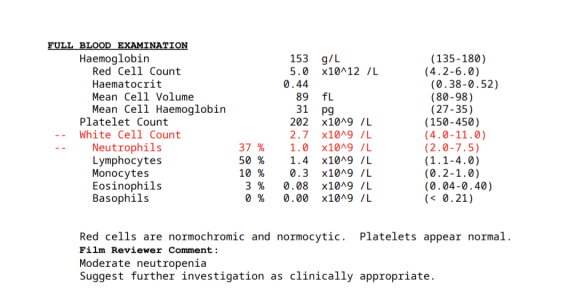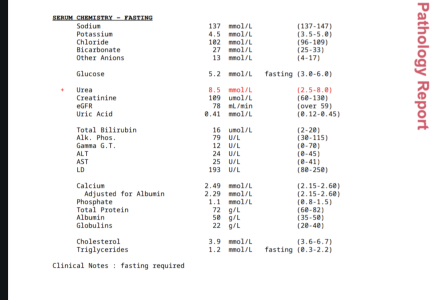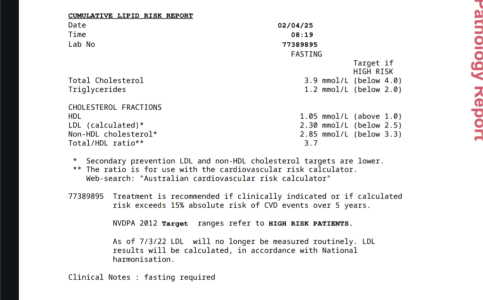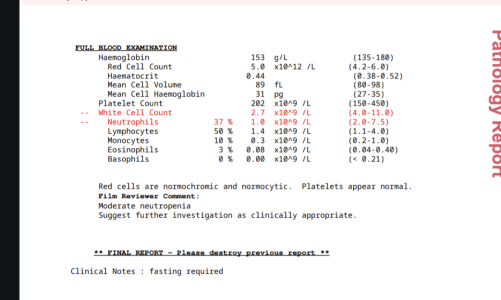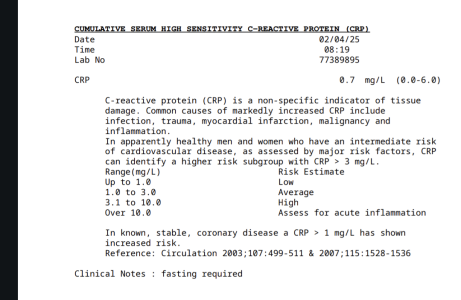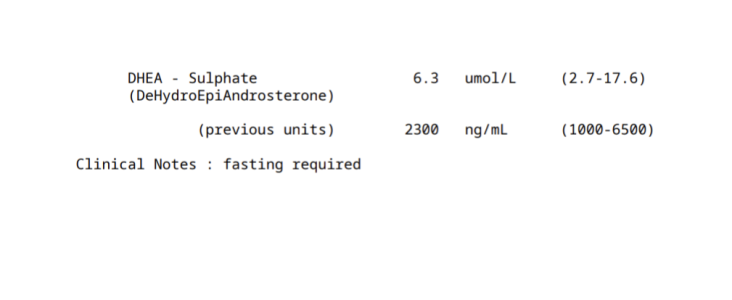You are using an out of date browser. It may not display this or other websites correctly.
You should upgrade or use an alternative browser.
You should upgrade or use an alternative browser.
First cycle adive
- Thread starter md1
- Start date
-
- Tags
- cycle first cycle test e
How does this look to be running 500mg a week or should a lower does be beneficialThese are normal results for someone who trains a lot (training impact shbg,free T, oestradiol)
How does this look to be running 500mg a week or should a lower does be beneficial
Projected Hormonal Profile Changes: 16 Weeks of Supraphysiological Testosterone (500mg/week)
Comparative ****ysis of Hormonal Parameters
| Hormone | Current Value | Projected Value (16 weeks) | Reference Range | Magnitude of Change | Physiological Significance |
|---|---|---|---|---|---|
| Total Testosterone | 26 nmol/L | 70-150 nmol/L | 10.0-33.0 nmol/L | ↑↑↑ 3-6× increase | Supraphysiological androgen exposure; greatly exceeds normal physiological range |
| Free Testosterone (calc) | 347 pmol/L | 1500-3000 pmol/L | 150-700 pmol/L | ↑↑↑ 4-9× increase | Dramatic elevation in bioavailable testosterone; drives anabolic effects in target tissues |
| Luteinizing Hormone (LH) | 7 IU/L | <0.5 IU/L | 1-10 IU/L | ↓↓↓ >90% decrease | Complete HPG axis suppression due to negative feedback on hypothalamus and pituitary |
| Follicle Stimulating Hormone (FSH) | 5 IU/L | <0.5 IU/L | 1-10 IU/L | ↓↓↓ >90% decrease | Suppression of spermatogenesis; potential long-term fertility implications |
| Oestradiol | 145 pmol/L | 250-400+ pmol/L | <150 pmol/L | ↑↑ 70-175% increase | Elevated due to increased aromatization of excess testosterone; potential gynecomastia risk |
| *** Hormone Binding Globulin | 64 nmol/L | 15-25 nmol/L | 13-71 nmol/L | ↓↓ 60-75% decrease | Androgen-mediated suppression of hepatic SHBG production |
| Prolactin | 160 mIU/L | 120-180 mIU/L | <300 mIU/L | ↔ Minimal change | Generally not directly affected by testosterone administration |
| Progesterone | 2 nmol/L | 1-2 nmol/L | <3 nmol/L | ↔ Minimal change | Minimal direct effect of exogenous testosterone on progesterone levels |
Additional Parameters Not in Original Panel
| Parameter | Expected Change | Physiological Significance |
|---|---|---|
| Hematocrit | ↑↑ Significant increase | Increased erythropoiesis; potential polycythemia risk |
| Hemoglobin | ↑↑ Significant increase | Increased oxygen-carrying capacity; potential cardiovascular strain |
| HDL Cholesterol | ↓↓ Significant decrease | Adverse lipid profile changes; increased cardiovascular risk |
| LDL Cholesterol | ↑ Moderate increase | Altered hepatic lipid metabolism |
| ALT/AST (Liver enzymes) | ↑ Mild-moderate increase | Potential hepatic stress from metabolizing exogenous androgens |
| Sperm Count | ↓↓↓ Severe decrease | Suppressed spermatogenesis; temporary infertility |
| Insulin Sensitivity | ↑↓ Variable effects | Complex interaction with glucose metabolism; potential initial improvement followed by possible deterioration |
Recovery Timeline Post-Cessation
Duration of suppression after discontinuation varies significantly between individuals. Approximate expectations:| Parameter | Recovery Timeframe | Factors Affecting Recovery |
|---|---|---|
| HPG Axis Function (LH/FSH) | 4 weeks - 12+ months | Duration of use, individual genetics, post-cycle therapy protocol |
| Spermatogenesis | 3-12+ months | Age, prior fertility status, duration of suppression |
| SHBG | 2-8 weeks | Baseline levels, body composition, metabolic health |
| Hematological Parameters | 4-16 weeks | Baseline values, hydration status, other medications |
Clinical Implications
The projected hormonal alterations represent a significant deviation from physiological homeostasis with multiple potential health implications:- Reproductive System: Profound suppression of the HPG axis with risk of prolonged hypogonadism after cessation
- Cardiovascular System: Altered lipid profile, increased hematocrit, and potential blood pressure effects
- Psychological Effects: Potential mood alterations, including aggression or emotional lability
- Metabolic Effects: Changes in body composition, insulin sensitivity, and hepatic function
- Cosmetic Effects: Potential for accelerated male pattern baldness, acne, and gynecomastia
Methodological Considerations
These projections represent averages based on research literature. Individual responses may vary significantly due to:- Genetic polymorphisms affecting androgen metabolism
- Age-related differences in hormonal responsiveness
- Concurrent medications or supplements
- Body composition and metabolic health
- Psychological and environmental factors
- Compliance with administration protocol
- Quality and purity of administered testosterone
Note: This ****ysis is provided for academic purposes only and should not be interpreted as medical advice or endorsement of supraphysiological testosterone use. Such usage carries significant health risks and legal implications in many jurisdictions.
here for 150mg, but going on gear is probably a pretty bad idea at your age and fitness level,How does this look to be running 500mg a week or should a lower does be beneficial
Projected Hormonal Profile Changes: 16 Weeks of Testosterone (150mg/week)
31-Year-Old Athletic Male with 10% Body Fat
Comparative ****ysis of Hormonal Parameters
| Hormone | Current Value | Projected Value (150mg/week) | Reference Range | Magnitude of Change | Physiological Significance |
|---|---|---|---|---|---|
| Total Testosterone | 26 nmol/L | 35-55 nmol/L | 10.0-33.0 nmol/L | ↑ 1.3-2.1× increase | Mild-moderate supraphysiological elevation; just above or near upper physiological limit |
| Free Testosterone (calc) | 347 pmol/L | 700-1000 pmol/L | 150-700 pmol/L | ↑ 2-2.9× increase | Modestly elevated bioavailable testosterone; sufficient for anabolic effects with reduced side effect risk |
| Luteinizing Hormone (LH) | 7 IU/L | 0.8-2.0 IU/L | 1-10 IU/L | ↓↓ 70-89% decrease | Significant but potentially partial HPG axis suppression |
| Follicle Stimulating Hormone (FSH) | 5 IU/L | 1.0-2.0 IU/L | 1-10 IU/L | ↓↓ 60-80% decrease | Moderate suppression of spermatogenesis; more favorable for recovery |
| Oestradiol | 145 pmol/L | 160-220 pmol/L | <150 pmol/L | ↑ 10-50% increase | Modest elevation from baseline; lower risk profile for estrogen-related effects |
| *** Hormone Binding Globulin | 64 nmol/L | 35-45 nmol/L | 13-71 nmol/L | ↓ 30-45% decrease | Moderate suppression while remaining within physiological range |
| Prolactin | 160 mIU/L | 155-165 mIU/L | <300 mIU/L | ↔ Minimal change | Negligible impact at this dosage |
| Progesterone | 2 nmol/L | 1.8-2.0 nmol/L | <3 nmol/L | ↔ Minimal change | Negligible direct impact from exogenous testosterone |
Dose Comparison ****ysis
| Parameter | 150mg/week | 200mg/week | 500mg/week | Clinical Significance of 150mg Dose |
|---|---|---|---|---|
| Total Testosterone | 35-55 nmol/L | 45-70 nmol/L | 70-150 nmol/L | Closer to physiological range; less dramatic hormonal disruption |
| HPG Axis Suppression | Partial to significant | Significant | Complete | Potentially preserves some endogenous production |
| Estrogen Conversion | Modest elevation | Moderate elevation | Substantial elevation | Significantly reduced gynecomastia risk |
| Hematological Effects | Mild increase (1-3%) | Moderate increase (2-4%) | Significant increase (4-8%) | Substantially lower polycythemia risk |
| Lipid Profile Changes | Minimal to mild | Moderate | Significant | Less impact on cardiovascular risk markers |
| Recovery Time Frame | 1-4 months | 2-6 months | 4-12+ months | More favorable recovery profile |
Additional Parameters Not in Original Panel
| Parameter | Expected Change (150mg/week) | Physiological Significance |
|---|---|---|
| Hematocrit | ↑ Mild increase (1-3%) | Modest stimulation of erythropoiesis; low polycythemia risk |
| Hemoglobin | ↑ Mild increase (0.3-1.0 g/dL) | Slight increase in oxygen-carrying capacity |
| HDL Cholesterol | ↓ Mild decrease (5-15%) | Modest impact on cardioprotective lipoproteins |
| LDL Cholesterol | ↑ Minimal increase (0-10%) | Minor disruption of lipid metabolism |
| ALT/AST (Liver enzymes) | ↑ Minimal change | Minimal hepatic stress at this dosage |
| Sperm Count | ↓ Moderate decrease | Partial suppression of spermatogenesis with favorable recovery profile |
| Insulin Sensitivity | ↑ Mild improvement | Positive metabolic effects without significant complications |
Recovery Timeline for 150mg/week Protocol
| Parameter | Estimated Recovery Time | Factors Affecting Recovery |
|---|---|---|
| HPG Axis Function (LH/FSH) | 1-4 months | Less profound suppression allows more rapid recovery |
| Spermatogenesis | 2-6 months | Better preservation of testicular function |
| SHBG | 2-4 weeks | Milder suppression with prompt normalization |
| Hematological Parameters | 2-8 weeks | Minimal elevation allows quicker return to baseline |
Specific Considerations for Athletic Individual with Low Body Fat
- Performance Implications:
- Enhanced recovery between intense training sessions
- Modest improvements in strength and power output
- Potential for slight lean mass increase even in already athletic individual
- Lower risk of performance disruption from side effects
- Hormonal Equilibrium:
- For an individual with 10% body fat:
- Less dramatic aromatization due to lower adipose tissue
- Potentially more favorable testosterone:estrogen ratio
- Lower likelihood of requiring estrogen management strategies
- For an individual with 10% body fat:
- Therapeutic vs. Enhancement Threshold:
- 150mg/week represents a dose that falls near the upper boundary between:
- High-normal therapeutic replacement
- Low-end performance enhancement
- May provide subjective well-being benefits with modest performance enhancement
- 150mg/week represents a dose that falls near the upper boundary between:
- Regulatory Considerations:
- Within prescribable range for testosterone replacement therapy (TRT)
- May produce therapeutic testosterone levels in some individuals
- Typically requires medical supervision and monitoring
Methodological Limitations
These projections are educated estimates based on research literature and clinical observations. Individual responses may vary significantly due to:- Genetic factors affecting testosterone metabolism
- Individual variations in hypothalamic-pituitary sensitivity
- Testosterone ester pharmacokinetics (not specified in query)
- Administration frequency and resulting hormonal stability
- Individual aromatase activity levels
- Concurrent nutritional and training variables
Note: This ****ysis is provided strictly for academic purposes and should not be interpreted as medical advice or endorsement of testosterone use outside therapeutic contexts. Even at lower doses, exogenous testosterone administration should occur only under appropriate medical supervision.
here for 150mg, but going on gear is probably a pretty bad idea at your age and fitness level,
I'll deep into it and give it a read! Cheers
In your opinion what's the concerning cons for me, that you think I should consider??
Claude (I tested with my blood tests, and the projections were extremely accurate at the lower bound.)I'll deep into it and give it a read! Cheerswhich site did you collect this info from??
In your opinion what's the concerning cons for me, that you think I should consider??
LH and FSH levels often do not fully rebound, leading to low testosterone and fertility issues. I believe that anabolic steroids can be beneficial after having children, especially for individuals over 45 or 50, when maintaining or building muscle and stamina becomes challenging.
Last edited:
Put up all 10 mate tells us lots more.Just got my bloods done
They are all across 10 pages but here's my test levelsView attachment 3216
Test is fine not crazy high but your not low
Put up all 10 mate tells us lots more.
Test is fine not crazy high but your not low
Attachments
Good pick up, thank. dont know how to exactly hahahPlease Remove the one with your name
Should I be trying to lower the high oestradiol? My research has suggested my current diet should be good to keep it lower and balancedHigh oestradiol, with this low %BF, could create anxiety issues, like your white cells; this could be related to high-intensity training. Congratulations for being that motivated
Welcome to the forum brotherShould I be trying to lower the high oestradiol? My research has suggested my current diet should be good to keep it lower and balanced
Your oestradiol level in the results is 145 pmol/L which falls within the normal range <150 pmol/L - not sure what the concern is?
Thanks dude, I guess because it's on the higher end of normal, worried when I start to cycle it will really spike??Welcome to the forum brother
Your oestradiol level in the results is 145 pmol/L which falls within the normal range <150 pmol/L - not sure what the concern is?
Yeah fair point and totally get the concern. Once you start a cycle, especially with aromatising compounds like Test, oestradiol can shoot up fast depending on your sensitivity and dose. Best move is to keep an eye on it with mid cycle bloods and have an AI like Arimidex or Aromasin on hand just in case....... but don’t crash your E2 either  . There is a chance you may not need anything but it’s always smart to be prepared.
. There is a chance you may not need anything but it’s always smart to be prepared.
Yeah cool thanks I ordered some arimidex to come with the test. So best just wait until I notice symptoms before acting ???Yeah fair point and totally get the concern. Once you start a cycle, especially with aromatising compounds like Test, oestradiol can shoot up fast depending on your sensitivity and dose. Best move is to keep an eye on it with mid cycle bloods and have an AI like Arimidex or Aromasin on hand just in case....... but don’t crash your E2 either. There is a chance you may not need anything but it’s always smart to be prepared.
slider45
Registered
Machine!Hey, looking at starting my first cycle. 31, 1.78cm and 85kg atm, arms measuring 16.5inches and have been hitting the gym for 7 years now. Attached a few photos of my current physic.
Looking at running 500mg a week for 12-14 weeks. Will spread it out to 2 injections a week. Should I look at stack it when anything else? Would this much be suitable for my current physic.
Also, I'm worried mostly about hair loss, currently have no receding hairline. Is it would to use shampoos or take anti hair loss pills?
I'll also have arimidex and nolvadex on hand and of course.
Any help would be great
Pic of current physic for reference
View attachment 3160
Thanks broMachine!
Hi there, although I agree with almost everyone who has commented on this. I would also say if you want to hit the juice then it’s your choice but remember it’s a life choice because almost everyone who has tried 1 cycle will go on to do more. Now with all of that out of the way I would suggest go and get your bloods done ( as many markers as possible) . Then 1 ml of test per week (250-300) depending on your source. After a month go and get your bloods done and see where your test and your E2 levels are at and then go from there. Wait another month then go up to 1.5 mls a week . Then follow the same process until you find the right amount of test you can run with out many side effects. Good luckHey, looking at starting my first cycle. 31, 1.78cm and 85kg atm, arms measuring 16.5inches and have been hitting the gym for 7 years now. Attached a few photos of my current physic.
Looking at running 500mg a week for 12-14 weeks. Will spread it out to 2 injections a week. Should I look at stack it when anything else? Would this much be suitable for my current physic.
Also, I'm worried mostly about hair loss, currently have no receding hairline. Is it would to use shampoos or take anti hair loss pills?
I'll also have arimidex and nolvadex on hand and of course.
Any help would be great
Pic of current physic for reference
View attachment 3160
powerlifterbro
Registered
Some good advice by all 


Similar threads
- Replies
- 3
- Views
- 422
Approved Log
My Test E MK677 Anavar cycle log
- Replies
- 140
- Views
- 5K
Approved Log
My Training Log - First Cycle Log
- Replies
- 457
- Views
- 11K

